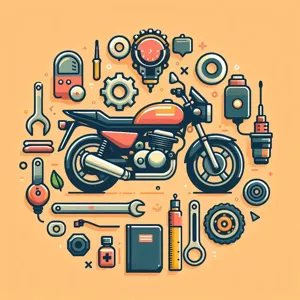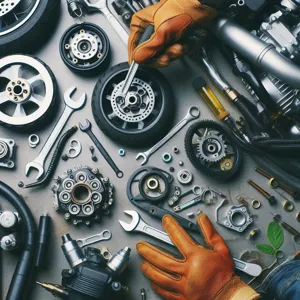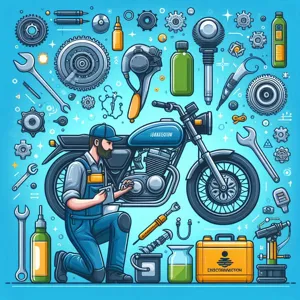Owning a motorbike is not just about the thrill of the ride; it also comes with the responsibility of keeping it in top-notch condition.
However, many riders unknowingly fall into common maintenance traps that can compromise their bike’s performance, safety, and longevity. From neglecting basic checks to overlooking crucial fluids, these maintenance missteps can lead to costly repairs and diminished riding experiences. In this blog post, we’ll uncover the top seven motorbike maintenance mistakes you didn’t know you were making, shedding light on the subtle oversights that could be holding you back from a smoother, more enjoyable ride. Whether you’re a seasoned biker or a newcomer to the world of two wheels, this guide will equip you with the knowledge to keep your motorbike in peak condition and ensure that every journey is as exhilarating as the last. Strap in and get ready to elevate your maintenance game!
1. Introduction: The Importance of Proper Motorbike Maintenance

Motorbikes are not just a mode of transportation; they are a passion for many and a lifestyle for some. However, owning a motorbike comes with the immense responsibility of proper maintenance. Neglecting even the smallest maintenance tasks can lead to major headaches, from decreased performance to costly repairs and, in the worst-case scenario, dangerous situations on the road.
Understanding the importance of proper motorbike maintenance is crucial for every rider. A well-maintained bike not only enhances your riding experience but also ensures safety and longevity for your machine. Think of maintenance as a preventive measure, much like regular check-ups for your health. Just as you wouldn’t ignore persistent aches or pains, your motorbike deserves the same level of attention to detail and care.
Many riders, especially those new to the biking world, may not realize the common pitfalls that can lead to neglect. From overlooking routine oil changes to misjudging tire pressure, these mistakes can significantly impact your bike’s performance. The key to avoiding these issues lies in education and awareness. By understanding the essential aspects of motorbike maintenance, you can enhance your riding experience, save money in the long run, and, most importantly, ensure your safety on the road.
In this blog post, we’ll delve into the top seven motorbike maintenance mistakes that you might not even know you’re making. By identifying these pitfalls and learning how to avoid them, you’ll be well on your way to becoming a more conscientious and informed rider, keeping your bike—and yourself—safe and sound. So let’s rev up and explore the world of motorbike maintenance!
2. Overlooking Regular Oil Changes
When it comes to maintaining your motorbike, one of the most critical yet often neglected tasks is keeping up with regular oil changes. Oil acts as the lifeblood of your engine, ensuring that all moving parts operate smoothly and efficiently. However, many riders fall into the trap of thinking that oil changes are only necessary when the bike starts to show signs of distress or when they hit a certain mileage milestone. This misconception can lead to significant engine wear and, ultimately, costly repairs.
Neglecting to change your oil on a regular schedule allows dirt, debris, and sludge to build up, compromising the oil’s ability to lubricate and protect the engine. This can cause overheating, increased friction, and a decline in overall performance. Furthermore, old oil loses its viscosity and can’t effectively carry away the heat generated by the engine, leading to potential overheating and breakdown.
To avoid this common pitfall, familiarize yourself with your motorbike’s manufacturer recommendations for oil change intervals. Depending on your riding style, environment, and type of oil used, these intervals can vary significantly. As a general rule, it’s wise to change your oil every 3,000 to 5,000 miles, or at least once a season for those who ride less frequently.
Additionally, make sure to check your oil level regularly and top it off when necessary. A quick dipstick check can save you from a world of trouble, ensuring your engine remains well-lubricated and functioning at its best. By prioritizing regular oil changes, you not only enhance your bike’s longevity but also elevate your riding experience, giving you peace of mind on every journey.
3. Ignoring Tire Pressure and Tread Depth

Tires are the unsung heroes of your motorbike, acting as the crucial point of contact between you and the road. However, many riders overlook the significance of maintaining proper tire pressure and tread depth, leading to potentially dangerous situations. Ignoring these factors can not only compromise your safety but also diminish your bike’s performance and fuel efficiency.
Proper tire pressure is essential for optimal handling and stability. Riding on under-inflated tires can result in sluggish response times and increased wear, while over-inflated tires can lead to a harsh ride and reduced traction. To ensure you’re riding on the right pressure, consult your motorcycle’s owner manual for the manufacturer’s recommendations. Investing in a reliable tire pressure gauge can make it easy to check and adjust your tire pressure regularly, ideally before each ride.
Equally important is the tread depth of your tires. Tread plays a critical role in providing grip, especially in wet conditions. As tires wear down, their ability to channel water away diminishes, increasing the risk of hydroplaning. A simple way to check tread depth is by using the “penny test”: insert a penny into the tread grooves with Lincoln’s head facing down. If you can see the top of his head, it’s time to replace your tires.
By keeping a vigilant eye on both tire pressure and tread depth, you enhance your safety, improve your bike’s performance, and extend the life of your tires. Remember, a well-maintained bike starts from the ground up, so don’t let these critical components slip through the cracks!
4. Neglecting the Chain: Cleaning and Lubrication
One of the most crucial components of your motorbike, the chain, often falls victim to neglect, yet its maintenance is pivotal for both performance and safety. A dirty or poorly lubricated chain can lead to a range of issues, from decreased power transfer to catastrophic failure while riding. The chain works hard, transmitting power from the engine to the rear wheel, and like any hardworking part, it needs regular attention to keep it functioning smoothly.
Cleaning your chain should be a part of your routine maintenance, ideally every 500 to 1,000 kilometers, or more frequently if you frequently ride in wet or dusty conditions. Many riders overlook this step, assuming that a little dirt won’t hurt anything. However, debris can wear down the chain and sprockets, leading to costly replacements and dangerous riding conditions. To clean it properly, invest in a good chain cleaner and a stiff brush to remove grime and buildup.
Once you’ve cleaned the chain, lubrication is paramount. A well-lubricated chain reduces friction, protects against rust, and helps maintain the longevity of both the chain and sprockets. It’s a simple process: apply the lubricant evenly while rotating the wheel, ensuring every link is coated. This will not only improve your bike’s performance but also enhance your riding experience by providing smoother shifts and a quieter ride.
Don’t underestimate the impact of a well-maintained chain; it’s a small detail that can lead to significant improvements in your bike’s overall functionality and safety. By prioritizing chain maintenance, you’ll not only extend the lifespan of your components but also ensure that your ride remains as exhilarating as it was on day one.
5. Skipping the Brake System Check

One of the most crucial yet often overlooked aspects of motorbike maintenance is the brake system check. Many riders assume that as long as their brakes feel responsive, they’re in good shape. However, this assumption can lead to dangerous consequences. Brake system failures are a leading cause of accidents, and neglecting to regularly inspect this critical component can put you at serious risk.
Regularly checking your brake pads, discs, and fluid levels should be a non-negotiable part of your maintenance routine. Worn brake pads can dramatically reduce stopping power, while contaminated brake fluid can lead to brake fade, where your brakes become less effective due to overheating. Additionally, air bubbles in the brake lines can compromise your braking response, making it essential to bleed your brakes regularly to ensure a solid, responsive feel.
Don’t just rely on the feel of the brakes when you pull the lever—make it a habit to inspect the entire brake system. Look for signs of wear or damage, such as uneven pad wear, cracking or warping in the discs, and any leaks in the brake lines. If you’re unsure, consult a professional mechanic for a thorough inspection. Making this check a routine part of your maintenance schedule not only enhances your riding safety but also prolongs the life of your bike and its components. So, don’t skip on this vital maintenance task—your safety depends on it!
6. Failing to Replace Worn-Out Filters
When it comes to motorbike maintenance, one of the most overlooked aspects is the importance of replacing worn-out filters. Whether it’s the air filter, oil filter, or fuel filter, these components play a critical role in ensuring your bike runs smoothly and efficiently. Neglecting them can lead to a cascade of problems that might not be immediately apparent but can severely impact your bike’s performance over time.
The air filter, for instance, is responsible for ensuring that clean air enters the engine. A clogged or dirty air filter restricts airflow, resulting in a rich fuel mixture that can lead to decreased fuel efficiency and increased emissions. This not only affects your riding experience but can also strain the engine, potentially leading to costly repairs down the line.
Similarly, the oil filter is essential for keeping your engine oil clean by trapping dirt and debris. If you fail to replace a worn-out oil filter, contaminants can circulate through your engine, leading to increased wear and tear. This can compromise your engine’s lubrication system, resulting in overheating or even catastrophic engine failure.
Fuel filters, often hidden away and easily forgotten, are just as crucial. A blocked fuel filter can disrupt the flow of gasoline to your engine, causing it to stutter or stall. In the worst-case scenario, it can lead to a complete breakdown when you’re out on the road.
Regularly checking and replacing these filters is a simple yet effective way to ensure your motorbike remains in top condition. Many manufacturers recommend replacement intervals, so adhering to these guidelines can save you from larger headaches in the future. By proactively maintaining your filters, you not only enhance your bike’s performance but also prolong its lifespan, allowing you to enjoy countless miles of smooth riding.
7. Disregarding Electrical System Maintenance

When it comes to motorbike maintenance, many riders often overlook the electrical system, assuming that as long as the bike starts and the lights work, everything is fine. However, this mindset can lead to costly mistakes and, worse yet, dangerous situations on the road. The electrical system of your bike is intricate, comprising components like the battery, wiring, fuses, and the charging system, all of which require regular attention.
One common mistake is neglecting the battery. Batteries can lose charge or corrode over time, which may result in poor starting performance or complete failure at the worst possible moment. Regularly checking battery terminals for corrosion, ensuring they are clean and tight, and testing the battery’s voltage can prevent unexpected breakdowns.
Another critical aspect is the wiring. Exposed or frayed wires can lead to shorts, which not only affect your bike’s performance but can also pose serious safety risks. Periodically inspecting the wiring harness for any signs of wear or damage is essential. If you notice any issues, addressing them promptly can save you from more extensive repairs down the line.
Fuses are small but mighty components of your bike’s electrical system. They protect circuits from overloads, and when they blow, it can leave you without essential functions like headlights or turn signals. Familiarizing yourself with the location of your fuses and having spares on hand can keep you from being stranded due to a blown fuse.
Lastly, while many riders may focus on the mechanical aspects of their bikes, the charging system is equally important. A failing stator or regulator can lead to battery drain, leaving you with a bike that won’t start. Regular checks and maintenance on this system can ensure that your bike is always ready to hit the road.
By giving the electrical system the attention it deserves, you’ll not only enhance your bike’s performance but also ensure a safer ride. Remember, a well-maintained electrical system is the backbone of your motorcycle, and neglecting it can lead to a host of problems that could easily be avoided.
8. Not Paying Attention to Fluid Levels
Maintaining optimal fluid levels is crucial for the health and performance of your motorbike, yet it’s one of the most commonly overlooked aspects of bike maintenance. Just like a human body requires hydration, your bike needs the right fluids to function smoothly. Ignoring this vital element can lead to a cascade of problems that could have easily been avoided with a quick check.
Motorbikes rely on various fluids, including engine oil, coolant, brake fluid, and transmission fluid, each serving a critical purpose. Engine oil lubricates moving parts, ensuring that everything runs smoothly while minimizing wear and tear. Coolant prevents the engine from overheating, particularly during those long summer rides. Brake fluid is essential for maintaining responsive braking, which is vital for your safety. And let’s not forget the transmission fluid, which helps keep your bike shifting smoothly.
Many riders make the mistake of checking fluid levels infrequently or, worse, not at all. This neglect can lead to severe engine damage, brake failure, or overheating—issues that could have been prevented with regular maintenance. A simple visual inspection can go a long way; look for signs of leaks, check for discoloration in the oil, or feel the texture of the brake fluid.
Moreover, be sure to follow your manufacturer’s recommendations for fluid changes and top-offs. Keeping a maintenance log can also help you track when fluids were last checked or replaced. By making fluid level checks a regular part of your maintenance routine, you’ll not only enhance your bike’s performance but also extend its lifespan, ensuring that you can enjoy countless thrilling rides in the future. Don’t let something as simple as fluid levels be the reason for a breakdown—stay vigilant and keep your bike running at its best!
9. Forgetting Seasonal Maintenance Checks
Seasonal maintenance checks are often overlooked by motorbike enthusiasts, yet they play a crucial role in ensuring the longevity and performance of your ride. As the seasons change, so do the demands placed on your motorcycle. Neglecting to adapt your maintenance routine accordingly can lead to a series of problems that could have easily been avoided.
For instance, as winter approaches, it’s essential to prepare your bike for colder temperatures. This means inspecting your battery, as cold weather can significantly reduce its efficiency. A quick check of the coolant levels and ensuring your tires are properly inflated can also prevent mishaps during those chilly rides. On the flip side, as summer rolls in, the heat can take a toll on your engine and tire pressure. Failing to check your oil levels can result in engine wear and tear, while under-inflated tires could affect your handling and safety on the road.
Moreover, each season brings unique challenges, such as the effects of road salt in winter or the increased likelihood of rain during spring. Seasonal checks should also include a thorough cleaning of your bike to remove any contaminants that can cause corrosion or damage. Investing a bit of time in seasonal maintenance ensures that your motorbike remains in top shape, enhancing your riding experience and keeping you safe on the road.
By incorporating seasonal checks into your maintenance routine, you not only extend the life of your motorcycle but also enhance its performance and safety. Don’t wait for a problem to arise; be proactive and make seasonal maintenance checks a regular part of your motorbike care regimen. It’s a simple yet effective way to ensure that your bike is always ready to hit the road, no matter the weather.
10. Using Incorrect Fuel Type
Using incorrect fuel type is a common oversight that many motorcycle owners may not even realize they’re making. While it might seem harmless to fill your bike with the same fuel you use in your car, the truth is that each motorcycle is designed to run optimally on a specific type of fuel. Whether your bike requires regular unleaded, premium, or even a specific ethanol blend, using the wrong fuel can lead to a variety of problems that not only affect performance but can also lead to costly repairs.
For instance, using a lower octane fuel than recommended can cause knocking or pinging in the engine, which diminishes power and can result in long-term damage if left unchecked. Conversely, filling up with a higher octane fuel than necessary often doesn’t provide any benefits and can actually lead to inefficient combustion. Additionally, some motorcycles may be sensitive to the ethanol content in fuel. Using fuel with a high ethanol blend can increase the risk of moisture buildup and fuel degradation, potentially harming the fuel system components.
To avoid these pitfalls, always refer to your owner’s manual to understand the fuel specifications for your motorcycle. If you’re unsure about the right fuel type, consult with your mechanic or a trusted dealer. By taking the time to fuel your bike correctly, you not only ensure smooth rides but also extend the life of your engine, keeping your two-wheeled companion in peak condition for years to come. Remember, the right fuel is one of the simplest yet most crucial aspects of your motorcycle maintenance routine!
11. Improper Storage Practices
Improper storage practices can lead to a range of issues that may compromise your motorbike’s performance and longevity. Many riders overlook the importance of how and where they store their bikes, often treating them as mere possessions rather than intricate machines that require care.
When storing your motorbike for an extended period, be mindful of the environment. Leaving your bike exposed to the elements can result in rust formation, fading paint, and other weather-related damage. Ideally, your motorcycle should be stored in a clean, dry space, such as a garage or shed, away from direct sunlight and dampness. If indoor storage isn’t an option, consider investing in a high-quality motorcycle cover that offers protection from rain, UV rays, and dust.
Additionally, neglecting to prepare your bike for storage can lead to a host of mechanical issues. Failing to top off fluids, for example, can result in moisture accumulation and corrosion within the engine. Before tucking your motorbike away, make sure you change the oil, fill up the fuel tank to prevent condensation, and add a fuel stabilizer to keep the fuel from degrading.
And let’s not forget about the tires—storing your motorcycle on the ground for long periods can cause flat spots. To avoid this, consider using a motorcycle stand or placing the bike on a tarp to reduce contact with the ground.
In summary, proper storage practices are crucial for maintaining the health of your motorbike. By taking the time to prepare your bike for storage and ensuring it is kept in an appropriate environment, you can spare yourself from costly repairs and extend the life of your beloved ride.
12. Ignoring Warning Signs from Your Bike
Ignoring warning signs from your bike can lead to costly repairs and, more importantly, safety hazards on the road. Every motorbike is equipped with a range of indicators and sounds that serve as a crucial communication link between you and your machine. When your bike starts behaving differently—be it unusual noises, vibrations, or warning lights—it’s your responsibility to pay attention rather than brushing them off as mere quirks.
For instance, if you hear a grinding noise when you apply the brakes, this could signal worn-out brake pads that need immediate attention. Similarly, if your bike starts pulling to one side during a ride, it could be a sign of an alignment issue or tire imbalance. These seemingly minor problems can escalate quickly, leading to more significant damage that could have been easily avoided with timely intervention.
Moreover, the sensations you feel while riding—like a bumpy ride or difficulties in shifting gears—should not be dismissed as normal wear and tear. It’s essential to approach these warning signs with a proactive mindset. Regularly inspecting your bike and keeping an ear out for anything out of the ordinary can save you both time and money in the long run.
Instead of waiting for a breakdown to address these issues, make it a habit to conduct routine checks and listen to what your bike is telling you. Remember, your motorcycle is your companion on the road, and understanding its language can lead to a safer, smoother, and more enjoyable riding experience. So, the next time you notice something off, don’t ignore it—take action before it’s too late.
13. DIY Maintenance Pitfalls
When it comes to keeping your motorbike in prime condition, the allure of DIY maintenance can be strong. Many riders embrace the hands-on approach, relishing the satisfaction of working on their machines. However, this enthusiasm can sometimes lead to costly mistakes if proper care isn’t taken. Here are some common DIY maintenance pitfalls that you might not even realize you’re making.
First and foremost, neglecting to consult your owner’s manual can lead to significant errors. Each bike has specific requirements for oil type, tire pressure, and service intervals, which are critical for optimal performance. Skipping this step can result in using the wrong products or missing vital maintenance tasks, ultimately affecting your bike’s longevity and safety.
Another common oversight is underestimating the importance of proper tools. Using makeshift tools or the wrong equipment can not only make the job harder but can also damage components. For instance, using a crescent wrench instead of a socket can strip bolts, leading to expensive repairs down the line. Investing in the right tools will save you time, frustration, and money in the long run.
Additionally, many riders fall victim to the “more is better” mentality, particularly when it comes to lubricants. Over-lubricating chains or cables might seem harmless, but it can attract dirt and debris, which can cause wear and tear. It’s crucial to follow guidelines for lubrication frequency and quantity to keep your bike operating smoothly.
Lastly, there’s often a tendency to overlook safety checks. While it’s easy to focus on cosmetic enhancements or performance upgrades, failing to inspect essential components like brakes, tires, and lights can jeopardize your safety on the road. Make it a habit to perform a thorough safety inspection regularly, even if you’re primarily focused on other maintenance tasks.
In conclusion, while DIY maintenance can be rewarding, it’s essential to approach it with caution and knowledge. By avoiding these common pitfalls, you’ll not only enhance your riding experience but also ensure the longevity and reliability of your beloved motorbike.
14. Conclusion: Prioritizing Proper Maintenance for Longevity
In conclusion, prioritizing proper maintenance for your motorbike is not just about preserving its performance; it’s about ensuring its longevity and your safety on the road. Each of the mistakes we’ve discussed highlights a critical aspect of bike care that can easily be overlooked in the flurry of daily life or during the thrill of riding. From neglecting regular oil changes to ignoring tire pressure checks, these seemingly minor oversights can lead to significant issues down the line.
By integrating a routine maintenance schedule into your riding lifestyle, you can avoid unnecessary repairs and costly replacements. Take the time to familiarize yourself with your bike’s manual, invest in quality maintenance tools, and don’t hesitate to seek professional help when you need it. Remember, a well-maintained motorbike not only enhances your riding experience but also ensures that you stay safe and confident on every journey.
As you ride into the horizon, let the lessons learned from this list guide your maintenance practices. Make it a habit to regularly inspect your bike and address any emerging issues promptly. By doing so, you’ll not only extend the life of your motorbike but also foster a deeper connection with your machine, allowing you to enjoy the open road for many thrilling miles to come. Happy riding, and may your adventures be as smooth as your bike’s performance!
15. Resources for Further Learning on Motorbike Care
When it comes to motorbike maintenance, knowledge is power. Understanding your bike’s intricacies and how to care for it properly can dramatically extend its lifespan and enhance your riding experience. Fortunately, there are a plethora of resources available to help you become a more informed and competent motorcycle owner.
Start with online forums and communities dedicated to motorcycling. Websites like Reddit’s r/motorcycles or dedicated motorcycle forums offer a wealth of shared experiences, tips, and advice from fellow riders. Here, you can ask questions, share your own experiences, and gain insights into maintenance practices that other riders swear by.
YouTube is another fantastic resource, filled with instructional videos that cover everything from basic maintenance tasks like oil changes and chain adjustments to more complex repairs. Channels run by experienced mechanics or avid motorcyclists can provide visual step-by-step guides, making even the most daunting tasks approachable.
For those who prefer a more structured approach, consider investing in books or manuals specific to your bike model. Many manufacturers publish owner’s manuals that contain vital information on maintenance schedules, recommended fluids, and troubleshooting common issues. Additionally, books like “The Essential Guide to Motorcycle Maintenance” can serve as comprehensive references to guide you through various maintenance tasks.
Don’t overlook local workshops or community college courses focused on motorcycle repair and maintenance. Many places offer hands-on training that can deepen your understanding and boost your confidence in performing repairs yourself. Plus, interacting with seasoned professionals can provide tips and tricks that you won’t find in any book or video.
Lastly, don’t forget to follow trusted motorcycling blogs and websites that regularly publish articles on maintenance tips, product reviews, and industry news. Staying informed about the latest tools and techniques can help you avoid common pitfalls and keep your bike in peak condition.
By leveraging these resources, you can transform your motorcycle care routine from trial-and-error to informed precision, ensuring your ride remains reliable and enjoyable for years to come.
As we wrap up our exploration of the top 7 motorbike maintenance mistakes you didn’t know you were making, we hope you feel empowered to take your bike’s care to the next level. Proper maintenance is crucial for ensuring not just the longevity and performance of your motorcycle, but also your safety on the road. By avoiding these common pitfalls and implementing the tips we’ve shared, you can ride with confidence, knowing your bike is in optimal condition. Remember, every ride is a chance to enjoy the open road, so treat your motorbike right! Here’s to many more thrilling adventures ahead—stay safe and keep your wheels turning smoothly!






